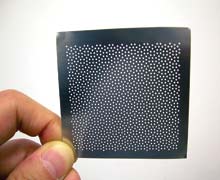From the Labs: Information Technology
Filtering Terahertz Frequencies
A new type of filter could make extremely fast wireless communication devices possible

Source: “Transmission Resonances through Aperiodic Arrays of Subwavelength Apertures”
Tatsunosuke Matsui et al.
Nature 446: 517-521
Results: Researchers at the University of Utah have designed a perforated stainless-steel film that restricts the frequencies of terahertz radiation passing through it. In effect, the film is a simple terahertz filter, a potential precursor to terahertz communication devices.
Why it matters: The filter could provide a way to control terahertz radiation in future wireless devices. Though still years from commercialization, wireless networks that use this radiation–which technically ranges from about 100 gigahertz to 10 terahertz–could carry much more data than existing networks, speeding up wireless Internet links by a factor of a thousand. Terahertz transmission would be most useful for relatively short-range communication–between devices in a room, for example.
Methods: The new filter is made of stainless steel with arrays of holes in it. When terahertz radiation passes through the holes, it propagates as a terahertz wave with a few narrow frequency bands; the frequencies emitted depend on the spacing of the holes. Where previous studies had assumed that uniform arrays were necessary for terahertz filtration, the Utah researchers used irregular arrays of perforations, allowing several different frequencies of radiation to pass through the filter at the same time.
Next steps: The researchers will now try to build terahertz communication devices based on the principles demonstrated by their work thus far.
Touch Screens That Vibrate
A touch screen that offers tactile feedback could help people type more accurately on PDAs
Source: “Tactile Feedback for Mobile Interactions”
Stephen Brewster et al.
CHI 2007, April 28-May 3, 2007, San Jose, CA
Results: Researchers at the University of Glasgow, Scotland, have found that mobile phones and PDAs whose touch screens vibrate when touched promote better typing and are easier to use than nonvibrating devices. In the lab, subjects made 22 percent fewer typing errors and were able to correct 48 percent more of their errors when they used vibrating PDAs. Those benefits diminished somewhat when subjects were tested on a moving train.
Why it matters: More and more phones are being designed to let users enter numbers and letters using touch screens. But virtual buttons on a flat display simply don’t feel like buttons, and people using them are prone to errors. Some researchers suspect that adding tactile cues–such as vibrations when a screen is touched–will improve the interface.
Methods: To the backs of several PDAs, the researchers attached actuators that caused the gadgets to vibrate when their touch screens were tapped. The vibration was smooth when a subject pressed a button correctly but rougher if the subject made a mistake, such as tapping a button twice. Twelve study participants, who had never used PDAs before, were given poems to type into the devices as accurately and quickly as possible, both in the lab and on a moving train.
Next steps: The group is exploring additional ways of using actuators in mobile devices. For example, actuators at the four corners of a device could denote the progress of a file download: the actuators would vibrate in sequence until the download was complete.
Keep Reading
Most Popular
Large language models can do jaw-dropping things. But nobody knows exactly why.
And that's a problem. Figuring it out is one of the biggest scientific puzzles of our time and a crucial step towards controlling more powerful future models.
The problem with plug-in hybrids? Their drivers.
Plug-in hybrids are often sold as a transition to EVs, but new data from Europe shows we’re still underestimating the emissions they produce.
Google DeepMind’s new generative model makes Super Mario–like games from scratch
Genie learns how to control games by watching hours and hours of video. It could help train next-gen robots too.
How scientists traced a mysterious covid case back to six toilets
When wastewater surveillance turns into a hunt for a single infected individual, the ethics get tricky.
Stay connected
Get the latest updates from
MIT Technology Review
Discover special offers, top stories, upcoming events, and more.